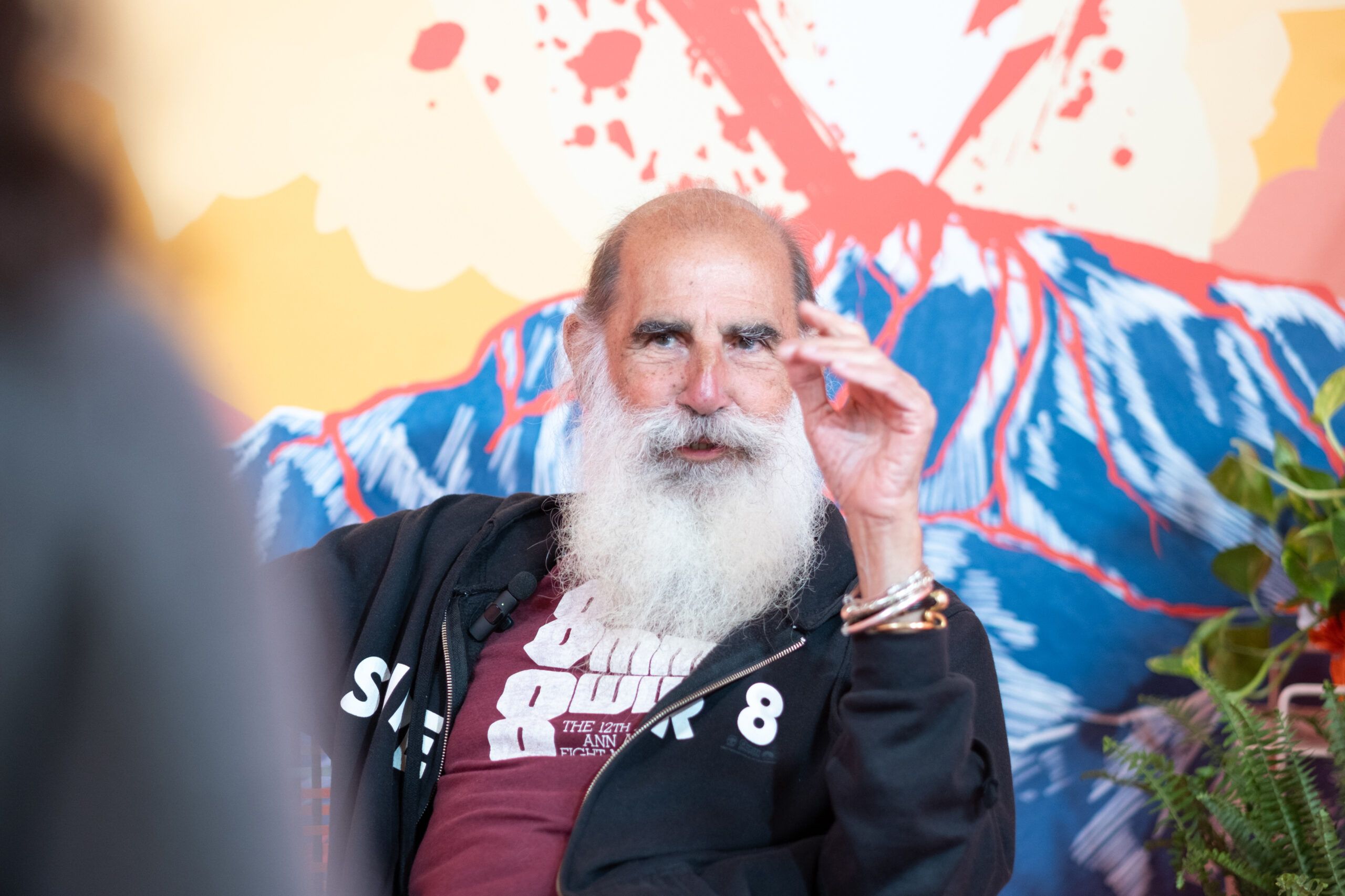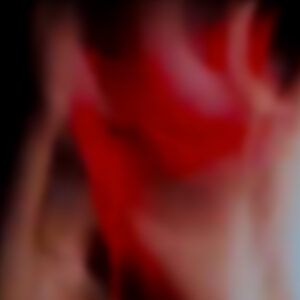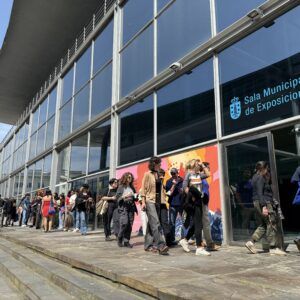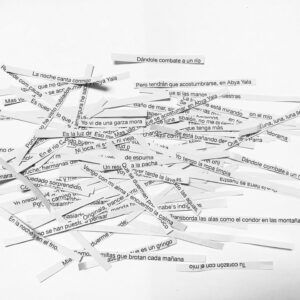We spoke with Carlos Castillo, a multidisciplinary and multifaceted artist, about his work and the fascinating Venezuelan avant-garde Super 8 movement of the 1970s and 1980s.

You come from other artistic disciplines such as drawing or sculpture, so how did you get into film?
My connection with the arts began in third grade, with a craft project I made in class that was selected as the best craft project ever carried out in that school. It was a frame that had been drawn whose back I later covered up, because it was thick, and I used it to put pencils on the desk. So, on top of the fact that I was enjoying that pure, clean, creative side of art, I was putting something to work. I didn’t know it, but the seed of design was also there, which I also worked in professionally at one point; I’m an industrial designer. Over time, this blend enabled me to become multidisciplinary. I’ve combined media such as photography, installation, sculpture, architecture, etc. throughout the years. That melange has always been very attractive to me, and I constantly try to keep it up.
As for film, it was very common in my home to see my father with his Bolex. We would get in the pick-up and travel all over Venezuela. He was a doctor and one of the founders of Social Security in Venezuela. He was very interested in the province and would take his camera and report on its events, filming. So I was already used to seeing a camera, and observing the process. But the spark for me was an advertisement that appeared in the press: a public call from the Mayor’s Office of Culture, but under the names Mercedes Márquez and Julio Neri, inviting anyone to take part in their event; all you needed was to be alive. That event was the first International Super 8 Avant-garde Film Festival in Venezuela. It was magical, because I saw that this combination of sound, image, motion, colour and many other things could be combined with the approach I’d been applying in other disciplines. My connection with cinema was also there in the film shows I was taken to on Saturdays as a child, which were called matinées and were held at 3:15. In the first film I made [Matinee 3:15], I recreate those shows. First, there were still images that were for advertising a product, or a shop or something. Then they showed some trailers or previews of the films that were going to be shown, and then the film itself. Precisely, I think I have recreated that film show with a few touches that can be classified as avant-garde. And that’s really my beginning, my first film. I adore it and I haven’t seen it since. My work isn’t exhibited on social media or anything like that. It’s going to be seen here, and I find that very exciting.
That film parodies commercial cinema, and there are other films in which you play a lot with the audience’s expectations based on the conventional language of cinema. I’m thinking, for example, of One for all and all for all…?!, or It’s really hot, this movie! I wonder where this impulse to criticise the medium comes from?
Matinee 3:15 put me in a cinema hall just like when I was a kid, and that commercial development that involves a presentation, a plotline, which seems too traditional to me, is still the same. You go into the darkness, you sit down and you start to see that; there’s no evolution in that sense. So I try to go a little further, to mix up the senses, to change the way I perceive those images. More than a criticism, I put forward an alternative. I do things and present them without any prejudice. Perhaps I’m too obvious in my proposal, because I say that the film burns and in fact it does burn; it’s the same in the case of One for all and all for all…?!, in which I express my doubts and let the viewer decide which film is theirs. Not all my films are like this, but I always have that desire to question our relationship with the moving image.
There are two films that we’re going to see in which a television monitor plays a part: Mum’s Chicken Soup and T.V.O. Can you tell us about them?
After seeing the result and the international success of Matinee 3:15, I said to myself: in addition to being a sculptor, I’m now a filmmaker, too. Seeing the reaction to what I was saying, I said to myself, “Let me get involved in a political thing for once,” and with my perspective at that time and the ingredients from my experience, I then did Made in Venezuela, which is a film that questions many things, with messages that need to be fully discovered, zombies wandering around places, all of that is there. The success of that film motivated me again. I told myself that if that was causing these reactions outside of here (because with this film I went to Iran, invited to a festival when the Shah’s dictatorship was still in place, and the public response was tremendous; they gave me the jury prize and the audience prize), I was left a bit with the idea of attacking what I perceived as problems or conflicts in society. At that time, television was gaining ground in the home; it was an important object in homes. And then I did T.V.O., with a commercial film actress, who discards the reality that upsets her to swap it for this antihero who appears on television. Then I began to get better at handling the medium, because Super 8 in Venezuela was the substitute for video art, since we didn’t have access to video, there was no portable equipment or anything like that, but with Super 8 there was the possibility of editing and having total autonomy to do whatever you wanted. In fact, when the festival was held, still with Julio and Mercedes, many of those of us who started with Super 8 came from other disciplines: Diego Rísquez, who was also multidisciplinary, and Jabardo and Moore, whose films I brought to share, by the way. We were all on the same page: on the one hand a call to politics, on the other simply visual enjoyment, and that’s where Super 8 became established in Venezuela.
Mum’s Chicken Soup is a film in which I propose that everyone make their own version; it’s a static shot in which you see a television with a character doing a lot of things, and next to it a woman cutting up a chicken. At that time, 200-foot Super 8 film appeared, with which very long takes could be shot, and with that I made that film with no cuts, so the viewer makes up their own montage according to which side of the shot they’re looking at.
I’d like to ask you about the links between your cinema and painting. In City vs. art, for example, there are a lot of things: on the one hand painting and on the other performance, because in a way you occupy a public space where you are painting live so as to record it with the camera. Can you tell us a little about this?
I’ve never abandoned the pictorial side. I believe in the possibility that we artists have to modify reality, to change what could be something as useless as a switched-off lighthouse at night and turn it into a beautiful national tree like the araguaney that appears in the film. That excites me. I never abandon painting, because it is the starting point for so many things. In fact, I now have a work that connects the origin of painting, which is found the hand in the Altamira caves at one end, and at the other end, a mobile phone, in dialogue.
How do “Super 8 Reality Interactions” come about?
I have a phrase and a stamp that I’ve been putting on my things since the 70s or 80s that says “Communicate-Action”, linking those things. The first piece I made in that sense was some very small pieces of paper with a seed, for example, of a bean, and a small text that says: “This piece is 1/500. Find the other 499 and with those beans you can make a wonderful dish for breakfast”, for example. You know you have a piece of a puzzle that is put together with those of so many other people who have them. I called it “Communicate-Action” and I liked it so much that I made some gloves to see exhibitions, because I saw a lot of people who would come, see the exhibitions and not understand much. So I made some gloves that are braided together, so if you put one on, another one is left free and you have to find another person who wants to see the exhibition, someone you don’t know who puts on the glove and starts walking with you. And that’s how that bond is created. I did it with a jacket, too: one sleeve is stuck to the other, so you have to kind of hug the other person. I believe a lot of communication is needed, and I contribute to that in some way, connecting the work with participation from people who don’t just remain onlookers but become an active part. When I was doing the Julio Neri Festival, I was taking part as a filmmaker and it was very good for me; I managed to present three or four new films every year. At that time, Super 8 began to gain a lot of international traction after we created a distribution network without realising it. I visited Iran at the time when the International Super 8 Film Federation was being founded with the Canadians, the Belgians, the Italians and the Spanish. Cinema was our destiny, and we achieved it. We went to Cannes, selected by the Directors’ Fortnight, which is the section for new trends, new filmmakers and alternatives. They invited us to participate, a selection of these countries, and they chose five films. In my case there were two: a Canadian one and Diego’s, which was a long one. The following year we took part again because it was an accepted format by then. But in our festival I needed something that wasn’t just a film. So I invented this thing called “Super 8 Interaction – Reality” because the word performance is very ostentatious and scientific. I made a piece where I am the one participating, which is El pájaro bañista (The bathing bird). And afterwards I thought about getting a little more involved, which is when I made my first interactive piece, Píntate de colores (Paint yourself with colours), and I made these pieces for the opening of the event, which I started directing because Julio and Mercedes had stopped doing it and switched to video. So I said, “Well, then I’m going to do the opening of the festival with something that isn’t within the cinematographic thing,” or at least I hadn’t seen it, and I started with those activities. Then I did Bienvenidos al color (Welcome to colour), and one of the last ones was No hay mar que por bien no venga (Every sea has a silver lining), which has an interesting ending and which I was very excited about projecting on the Berlin Wall, because there is a rupture there that I try to create, to tear it down cinematically.matográficamente.





